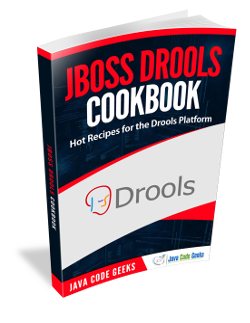JBoss Drools Tutorials
In this detailed Resource page, we feature an abundance of JBoss Drools Tutorials!
Drools is a business rule management system (BRMS) with a forward and backward chaining inference based rules engine, more correctly known as a production rule system, using an enhanced implementation of the Rete algorithm.
KIE (Knowledge Is Everything) is the new umbrella name to drools, optaPlanner, jBPM, Guvnor, uberFire and related technologies.
Drools supports the Java Rules Engine API (Java Specification Request 94)
Note
If you wish to build up your JBoss Drools knowledge first, check out our JBoss Drools Tutorial for Beginners.
If you wish to build up your JBoss Drools knowledge first, check out our JBoss Drools Tutorial for Beginners.
JBoss Drools Tutorials – Getting Started
Simple examples based on the JBoss Drools
- JBoss Drools Best Practices Tutorial
This example illustrates JBoss Drools and its best practices. We will also cover terminology used with Drools with little explanation. Before we proceed with this article, lets assume that readers have basic knowledge about how a Java n-tier application works. - JBoss Drools Fusion Tutorial
This tutorial is all about JBoss Drools Fusion. Before proceeding with this article, lets assume that readers have a basic knowledge into JBoss Drools and working of a Java n-tier application. To brief, Drools is a Business Rules Management System (BRMS) solution. It provides a core Business Rules Engine (BRE), a web authoring and rules management application (Drools Workbench) and an Eclipse IDE plugin for core development. To have more understanding of JBoss Drools please refer my article here. - Drools Rule Engine Tutorial
Drools is a Rule Engine that uses the rule-based approach to decouple logic from the system. The logic is external to the system in form of rules which when applied to data results into the decision making. A rules engine is a tool for executing business rules. In this article, we will write some business rules for a shopping domain model. - JBoss BRMS Drools Example
In this article, we will see an example of JBoss BRMS. BRMS is a JBoss Rules based server-side solution for the management, storage, editing and deployment of rules. JBoss BRMS 6 is backed by a GIT based repository, which is very much in line with how the mainstream enterprises are storing and working to deploy their projects.
JBoss Drools Tutorials – Functions
Learn the most famous functionalities and operations of the JBoss Drools
- JBoss Drools Spreadsheet Example
This example illustrates JBoss Drools Spreadsheet Example. Before proceeding with this article, we assume readers have a basic knowledge about how a Java n-tier application works. We also assume readers have good understanding of JBoss Drools. For more information on JBoss Drools please refer the article JBoss Drools Best Practices. - Jboss Drools Facthandle Example
In this article we will take a look on what is the FactHandle and how this works inside a drools engine implementing a example of this to ilustrate this feautre. - Jboss Drools AgendaEventListener Example
In this article we will take a look on how to use and implement an AgendaEventListener on a drools rule program. - Drools Backward Chaining Example
In this article, we will see a little introduction and example of what is backward chaining and how to implemente it with jboss drools. - JBoss Drools Guvnor Example
In this article, we will see an example of Drools Guvnor. We use Guvnor as ‘Business Rules Manager’. Guvnor is the name of the web and network related components for managing rules with drools. - Drools Expert System Example
In this article, we will see an example of Drools Expert system. An expert system’s goal is to help make a decision or solve a problem. Now to make a proper decision, it relies on are knowledge system and the working memory where we have the data that is to be applied on the knowledge system. - Drools Workflow Example
Workflow says exactly what will happen at each stage in the process. As soon as the workflow reaches a step, we will fire the actions associated with it. Ruleflow does something similar but we don’t have any control on the actual rules that may fire as they are selected by the rule engine. - Drools Salience Example
In this article we will look into an example of Drools Salience Example. So what is salience and why do we need it? Salience means to be most noticeable and important. We will use salience keyword against a rule to set the priority. Before we start with the example, let’s work on our setup. - Drools Decision Table Example
In this article we will look into an example of Drools Decision Tables. So what are Decision Tables? We know rules are defined in a drl file but if you have lots of similar rules with different values you can make use of Drools Decision Tables.
[undereg]


